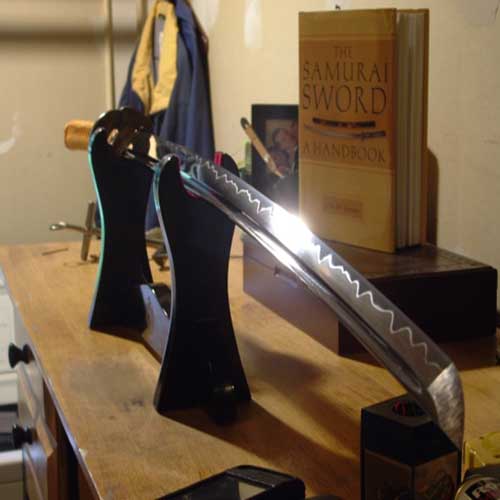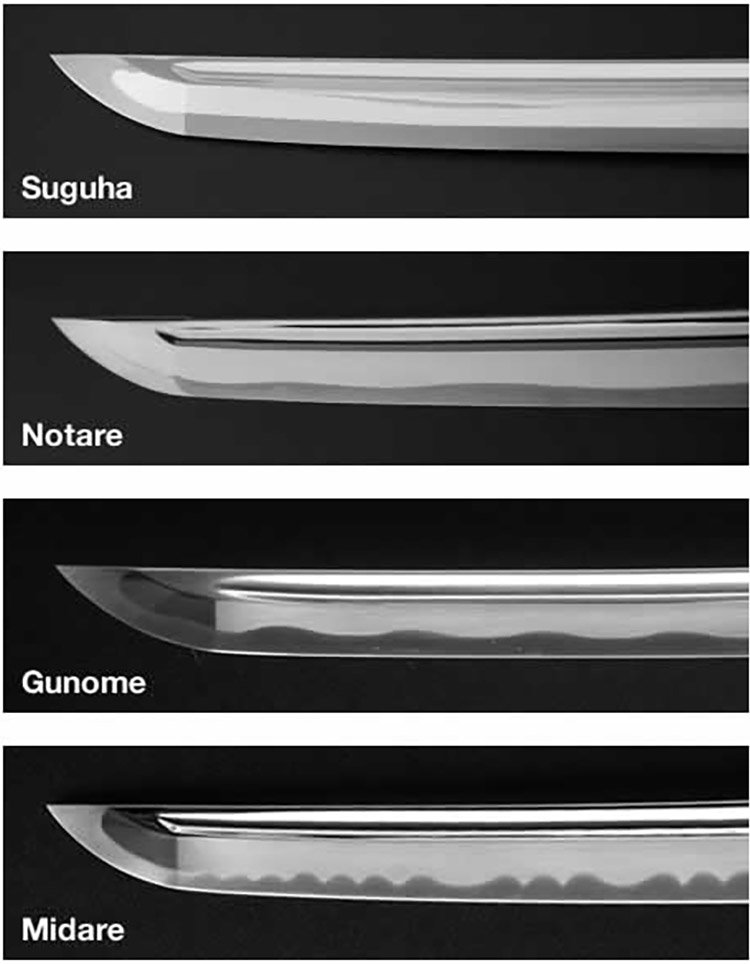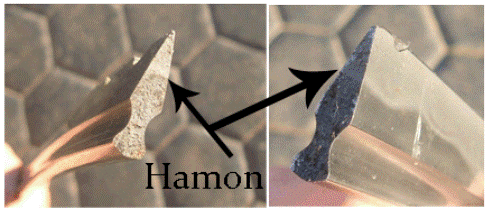Recent Articles
-
Christmas Sword Buying Guide 2025
Dec 03, 25 10:53 PM
Hamon

The hamon is a tempering line and visual point of demarcation on a Japanese sword which separates the harder edge from the softer spine and is a result of a process known as differential hardening.
Essentially, starting with a forged and straight blade, the spine is coated with a special mixture of clay so that, when heated and quenched, the edge cools much faster than the spine and turns the steel in the area of the hamon into a crystalline structure known as martensite (in Japanese, the big, easily seen crystals are called Nie and the smaller ones, Nioi).
This process is a critical point in the forging of a Katana, and has a relatively high failure rate - a pinging sound when tempering disqualifies the sword being made, which is factored into the overall price and why Katana with real tempering lines tend to be more expensive than monotempered (i.e. the same hardness all the way through) swords.
There are many types of temper line, but within them there are two main classifications - Suguha (straight) and Midare (wavy) and a single sword may combine more than one style depending on the personal taste and skill of the artisan making it.

A well made hamon that is visually appealing is a strong indication that the sword itself is well made. A good temper line is characterized by clear crystal formations, clean lines and lively 'activity'. It is also desirable that the temper line 'pop' when angled to a light source and as a result, they can be notoriously hard to photograph, fading in and out of visibility depending on how the light source is hitting it as shown in the video below.
The process of creating a real temper line is more than just cosmetically appealing. The martensite crystals result in a much harder, somewhat brittle edge (around 60 HRC) than the pearlite crystals of the spine, which is soft and somewhat shock absorbent (typically close to 40 HRC).
This tempering when done properly is not just visible on the surface, but goes all the way through the meat of the blade.
 Aftermath of some destructive sword testing clearly shows the martensite crystal structures permeate all the way through the blade
Aftermath of some destructive sword testing clearly shows the martensite crystal structures permeate all the way through the bladeOne the positive side, tempering a sword in the way allows the blade both to keep and hold a sharper edge while avoiding the entire blade becoming overly brittle and possibly snapping or breaking in half on impact with a hard target. The harder edge, even if not particularly sharp, also demonstrates superior cutting ability on softer targets such as bamboo, tatami mats, etc and makes for a better cutter overall (you can literally feel the difference, as a sword with a tempered edge just seems to cut so much easier).
The downside is that, because the blade has two different levels of hardness, if stressed laterally (sideways) it will tend to stay bent while a monotempered Katana without a hamon will (if well tempered) will tend to spring back to true.
This is not as big a problem as many people think, as the sword can be straightened out again and should not cause any real issues unless done multiple times (in which case, the bonds of the steel may weaken at the point where it has been repeatedly bent).
How to straighten a bent KatanaReal vs Fake Hamon
Because of the extra cost of making a Katana with a real hamon, both to get an artisan skilled enough to produce one and to absorb the relatively high failure rate during the quench - fake or purely cosmetic temper lines are commonly found on swords that have not actually been differentially hardened (i.e. monotempered).
There are several methods of creating a fake hamon - below is a video I filmed on location at a forge in China showing one popular method.
While some fake hamon are fairly easy to spot, others are much more subtle.
Some people mistakenly think that one way to tell if a hamon is real or not is to try to polish it out, after all - if a real temper line goes all the way through the cross section of the blade, it should still be visible if you polish off the surface.
However, this is not actually true - for polishing the blade to bring out the details of the temper line is an art form in itself, and many are actually acid etched to reveal the details. So much so that it is quite possible to completely obscure a real temper line using standard or inferior polishing techniques (to properly bring out the details, a hybrid polish is required - click the link to learn more).
As such, to the inexperienced sword collector who does not know how to reliably verify if a temper line is real or not, the only method (other than buying from a reputable, honest vendor who you can trust) is to use 'Rockwell Hardness Files" to check the relative hardness of the edge and the spine. If they are the same, then the temper line is most definitely not real.
I hope this information on hamon has been helpful. To return to Samurai Sword Terminology from Hamon, click here

Buying Swords Online Can Be DANGEROUS!
Find the Best Swords in the:
Popular & Recommended ARTICLES

The ONLY true free online magazine for sword enthusiasts. Delivered once a month on the 1st day of the month, no filler and no BS, just the latest sword news & info delivered straight to your inbox.












